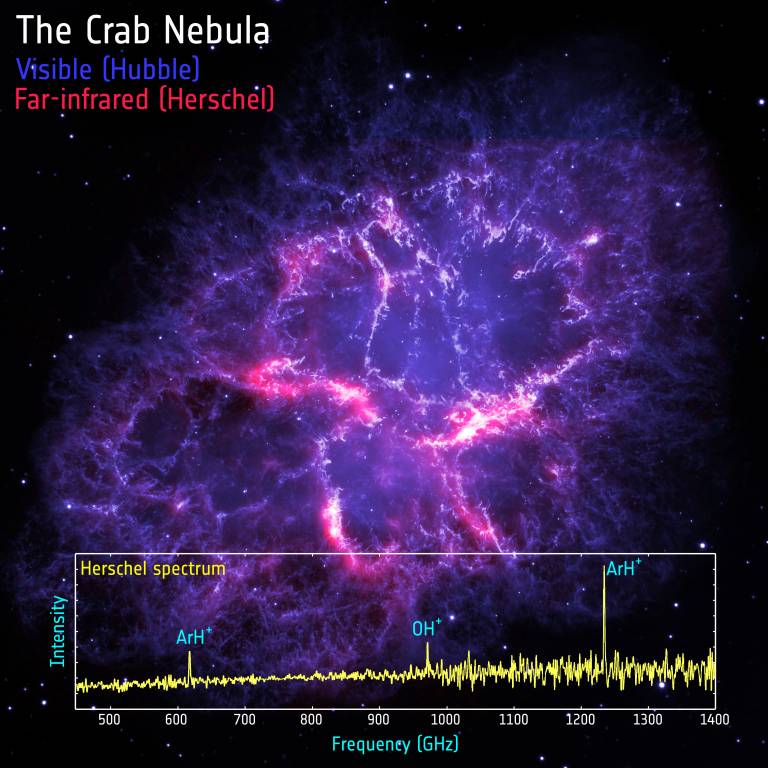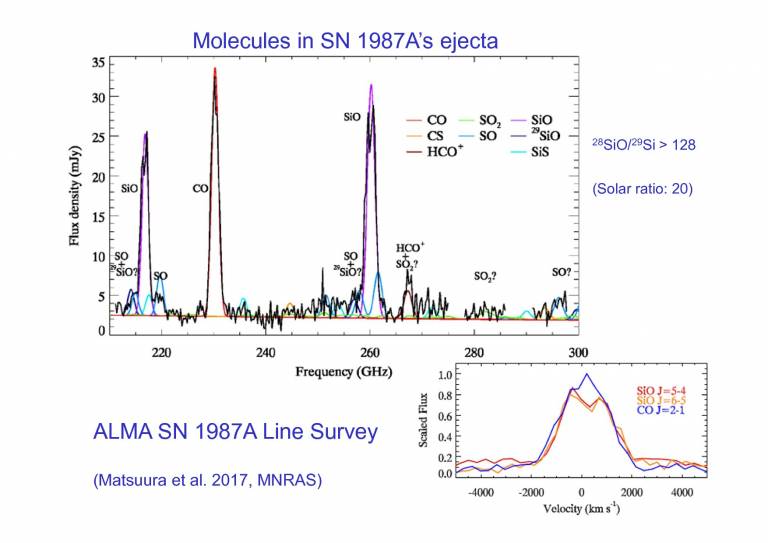The Crab Nebula
One of the most surprising discoveries made by the Herschel Space Observatory during its mission was the detection in the Crab Nebula of the noble gas molecule ArH+. This molecular ion, also known as argonium, had previously only been studied in the laboratory. Figure 1 shows a plot of a Herschel SPIRE FTS spectrum of a Crab Nebula knot in which the J=1-0 617.525 GHz and J=2-1 1234.603 GHz rotational transitions of 36ArH+ were both detected.

A Herschel SPIRE FTS spectrum (yellow) of one of the knots in the Crab Nebula in which the J=1-0 617.525 GHz and J=2-1 1234.603 GHz transitions of 36ArH were detected, representing the first detection of a noble gas molecule in space. The 971.804 GHz rotational transition of OH was also detected. The displayed spectrum is superposed on a composite optical/far-infrared image of the Crab Nebula (blue: a Hubble Space Telescope image taken in nebular emission lines; red: a Herschel PACS 70-micron image of the Crab's far-infrared dust emission.
36Ar is the dominant isotope of argon in the Universe and is synthesised by alpha-particle capture chain nuclear reactions in core collapse supernovae such as the Crab Nebula. The next most cosmically abundant isotope of argon is 38Ar, which in the solar wind is five times less abundant than 36Ar. The J=2-1 line of 36ArH+ is displaced by 1.75 GHz from the corresponding transition of 36ArH+ and, using our SPIRE FTS spectra of the Crab Nebula in which we detected 36ArH+, we were able to set a limit to the 36Ar/38Ar ratio of >2. The SPIRE FTS spectral resolving power at the frequency of those ArH+ lines was only 860, so we have scheduled higher spectral resolution ground-based observations of the J=1-0 ArH+ isotopologues in order to directly measure the 36Ar/38Ar ratio. This ratio will help diagnose the nuclear processes that operated in the progenitor star immediately before and during the explosion that produced the Crab Nebula.
ArH+ can be produced by the reaction H2 + Ar+ -> H + ArH+ but it can also be destroyed by the reaction H2 + ArH+ -> Ar + H3+. So although some H2 is necessary for the formation of ArH+, too much H2 can completely remove ArH+, unless more ionized argon is being generated rapidly. Astrochemical modelling that is underway in our group indicates that the intense flux of high energy charged particles present within the Crab Nebula can produce ionized argon at a rapid enough rate to account for the observed ArH+ line fluxes.
Supernova 1987A
Spectra of SN 1987A obtained with the Herschel SPIRE Fourier Transform Spectrometer recorded weak detections of the J=6-5 and J-7-6 rotational lines of the CO molecule, whilst early ALMA Band 3 and 6 spectra of SN 1987A recorded high signal-to-noise detections of the CO 1-0 and 2-1 rotational transitions of CO, whose FWHM line widths of 2200 km/s indicated an origin within the inner ejecta. An excitation analysis of the spectra implied at least 0.01 solar masses of emitting CO molecules. Further ALMA Band 6 and 7 time was allocated during Cycles 2 and 3 for studies of molecules and their isotopic variants in the ejecta of SN 1987A.

The upper panel in Figure 2 shows the 210-300 GHz spectrum of SN 1987A, showing detections of CO, SiO and HCO rotational lines. The lower panel shows a comparison of the CO and SiO velocity profiles, in which the SiO profiles clearly show a dip at the line peak that is not present in the CO line profile, indicating that the two molecular species have different spatial distributions within the ejecta.
he ALMA spectra yielded detections of CO, SiO and HCO+, as well as limits on the SiO isotopologues of 28SiO/29SiO > 128 and 28SiO/30SiO > 189 (compared to ratios of 19.7 and 20.9 for the Sun). These ratios are consistent with predictions that 28Si should be the dominant silicon isotope, created by alpha-particle capture reactions in the low-metallicity massive progenitor star immediately prior to its explosion as a core collapse supernova.
The above molecular line observations of the Crab Nebula and Supernova 1987A at far-infrared and submillimetre wavelengths have enabled isotope ratios to be measured in core collapse supernova remnants for the first time, providing a new and powerful probe of the nuclear processes that operate in massive stars during and immediately prior to their demise.
Publications
- Barlow et al. 2013, Science, 342, 1343.
- Kamenetzky et al. 2013, ApJ, 773, L34.
- Matsuura et al. 2017, MNRAS, in press.
 Close
Close

